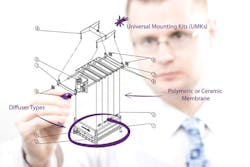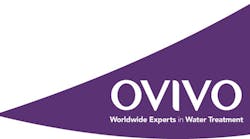Membrane bioreactor (MBR) market conditions are changing with the influx of newer companies and products. Moreover, related technologies are evolving quickly. For example, in terms of membrane equipment, Ovivo has seen overall efficiency improved at a rate of roughly 20% every two years dating back to 2001. The design of new-generation membrane products can target particular applications and or specific operating windows. With more than 70 types of membrane equipment on the market today, many with substantive differences between product features, more choices than ever are available. Nonetheless, in many cases, standard offerings are force fit into projects at some cost to the owner.
In order to get the most from MBR technology, system design and component selection must be tailored to match site-specific constraints. On the other hand, the industry is moving toward standardized equipment designs in an “open architecture” that will incentivize competition and bring costs down, benefitting the market as a whole. Examples of equipment design criteria include height, weight, capacity, clean frequency, membrane life, solids concentrations, flux, and energy. Customization as a driver seems to take on a bigger role in the selection process for membrane retrofit and replacement projects.
Retrofit, Replace, Reuse
Driving many of the MBR applications today are the three Rs: retrofit of an aging existing conventional treatment facility, replacement of older membrane technology, and reuse projects, which generally also include a retrofit component.
Retrofits and replacements are challenging installations compared to new construction applications. These installations must contend with existing basin geometry, and maintaining treatment capability during construction is extremely important. Applying a customizable solution requires system knowledge and innovation to make MBR more accessible for more “three R’s” projects.
Size Matters
MBR technology is being used successfully for retrofit, replacement and reuse projects and often reduces the project timeline, allows for quick (wet) installations and drives down capital and operational expenditures for the lowest cost option. In Canton, Ohio, construction began in March 2014 to update an aging extended aeration wastewater treatment plant. The construction will be done in six phases, while keeping the existing treatment plant in operation. Based on bid numbers, it will cost about $80 million to upgrade the 42-million-gal-per-day (mgd) plant to an MBR, or less than $2 per gallon of water treated.
On a much smaller scale, in 2013, a failing trickling filter was converted to novel single-stage MBR in Pembroke, Mass. The high-rate MBR installed in Pembroke—about 1,000 times smaller than the proposed system in Canton—has reliably produced reuse-quality effluent containing less than 7 mg/L of total nitrogen since August 2013 and has become the model for other projects in the area looking for improved treatment.
Projects involving water reuse, the retrofit of existing infrastructure and the replacement of older membrane equipment are becoming increasingly common. Over the past 13 years, the Running Springs Water District has successfully delivered all three types of projects. Located in the San Bernardino Mountains of Southern California, the Running Springs Wastewater Reclamation Plant (WRP) was originally built as a package plant in 1968 before being converted to a conventional activated sludge plant in the 1980s. Thanks to creative, forward-thinking operators, administrators and citizens, the Running Springs WRP is now an example of a successful MBR retrofit, replacement and reuse application.
The most recent upgrade included replacement of older membrane technology with customizable technology, taking into account a capacity increase from 0.6 to 1 mgd, energy optimization and basin geometry. Polymeric membranes in a taller design geometry, combined with high-efficiency diffusers, were selected from the standard set of component options. The higher packing density of the membranes reduced air scour from 1,200 scfm to 360 scfm. Moreover, the oxygen transfer efficiency of the selected integral diffusers is roughly 300% greater than it was with the old coarse bubble technology. While this improvement in efficiency currently is helping to reduce energy bills, it is interesting to note air scour requirements are expected to decrease even further, to 160 scfm, with the next upgrade.
With the retrofit and replacement of older membrane technology nearly 13 years after the initial MBR upgrade, Running Springs is an example of how far membrane technology has come in a relatively short period of time. Equipment is now more customizable, reliable and easier to maintain. New designs using the adaptable concept are nearly four times more energy- and space-efficient than the first-generation models. These plants are examples of a rapidly growing trend in wastewater treatment: Using customizable membrane equipment to rehabilitate older conventional plants is not only good for the environment; it is good for saving money.



